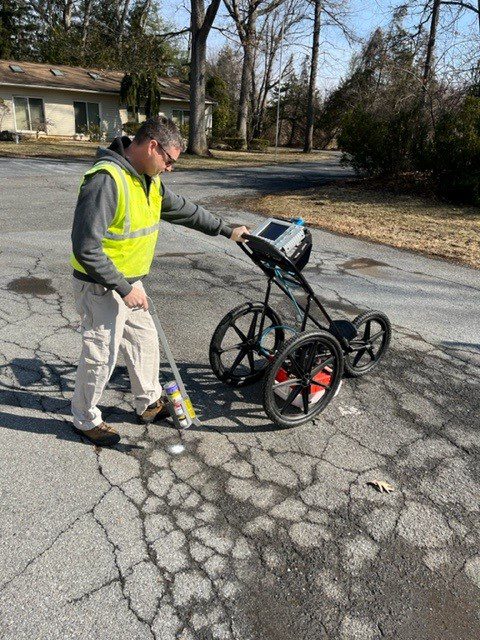Ambipar Response EMS Geophysics
Ambipar’s geophysical group employs a variety of non-destructive testing equipment to provide our clients with information about subsurface soils, utilities, structures, tanks, drums, voids, rebar and more.
We utilize state of the art underground sensing technology including:
Ground Penetrating Radar
Ground Penetrating Radar (GPR) utilizes high-frequency electromagnetic waves to map below-ground lithology or buried objects. GPR methods are both high-resolution and highly site specific, which means they can produce excellent results – but only in specific conditions.
How GPR Works
A GPR survey involves using a specialized antenna to focus electromagnetic pulses (radar signals) into the ground. These signals propagate and are then reflected by discontinuities or interfaces in soil materials and return to be detected by a receiver antenna.
The reflected signals are processed and displayed on a graphic screen and recorder. The time axis is converted to depth by an estimated velocity algorithm and associated software. As the antenna is moved along the surface, the graphic display results in a cross-section record of distance traveled vs. depth of the reflected radar signatures.
GPR Advantages and Limitations
GPR is one of the most effective high-resolution geophysical techniques available for shallow engineering and environmental projects. GPR profiles are spectacular in detection of plastic pipes, metal conduit, buried tanks, etc. when utilized to scan sandy soils. However, GPR has limited effectiveness in high attenuation, conductive soils such as saturated clay.
The depth of penetration of the GPR signal is a function of soil conditions and the frequency of the radar antenna. In general, an antenna with a lower frequency will penetrate deeper than an antenna with a higher frequency. However, the resolution and the ability to image smaller, targets increase with increasing frequency. We typically utilize a 400 MHz antenna for targets located within 1ft – 20 ft of the surface and a 2,000 MHz antenna for targets located within 1in – 12in of the surface (i.e. rebar in cement.)
Because the data is acquired in cross-sectional form (time vs. distance along the surface), objects not crossed at right angles or grazed may produce confusing signals. A second pass of the instrument at 90 degrees to the first pass may be required.
A GPR survey requires a relatively smooth surface (if the antenna bounces, the energy is not properly directed). Crew size is usually one person, but setup may be more efficiently done with two people.
Radio Detection (Conductive and Inductive)
 Radio detection has two modes of operation: CONDUCTIVE and INDUCTIVE.
Radio detection has two modes of operation: CONDUCTIVE and INDUCTIVE.
The CONDUCTIVE mode is utilized when a portion of a cable or pipe is exposed at the surface. A transmitter is attached directly to an exposed portion of the pipe or cable with a coupling clamp or ground rod assembly. The instrument detects the depth and direction of the utility.
The INDUCTIVE mode is utilized when there are no exposed portions of the underground utilities. A transmitter is used to induce an electromagnetic field into the ground. The transmitter radiates this field through both soil and water. In the inductive mode, the existence of metallic pipes are indicated but no depth information is provided.
Radio Detection Advantages and Limitations
Radio detection is highly effective in tracing metallic underground utilities. When the CONDUCTIVE mode is utilized, it is often possible to distinguish a single line among several crossing utilities. Radio detection can also be utilized in uneven terrain.
Radio detection cannot be used to detect plastic lines or other underground features such as disturbed sediments. GPR is much better at locating those features. However, in places where entrances to plastic piping can be located, such as in a storm drain, the line can often be traced by inserting a metallic fish tape into the length of pipe.
Electromagnetic Detection

Electromagnetic detection is utilized to detect buried metallic objects. Depth limitations are a function of the amount of metal in the object. A small near surface object will generate the same signal strength as a large more deeply buried object.
Electromagnetic Detection Advantages and Limitations
Electromagnetic detection can be used in uneven terrain. It can only be utilized to detect metallic objects and provides no depth information.
Geophysical Testing Applications
Geophysical testing applications include:
- Locating Buried Tanks & Drums
- Locating Underground Utilities
- Pre-clearing prior to installation of Monitoring Wells
- Landfill Delineation
- Archaeological Investigations
- Locating Graves & Cemetery Mapping
- Measuring Pavement Thickness
- Void and Sink Hole Mapping
- Golf Course Mapping
- Locate Backfilled Areas
Geophysical surveys are non-destructive and they can provide valuable subsurface information for decision making about construction, engineering or environmental projects. No individual subsurface detection and mapping technology is right for every situation, so we utilize several technologies on our projects and also use multiple antenna wavelengths and frequencies to provide the most accurate underground scanning results. Then we use state of the art 2D and 3D software for data analysis and presentation.
